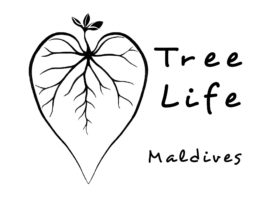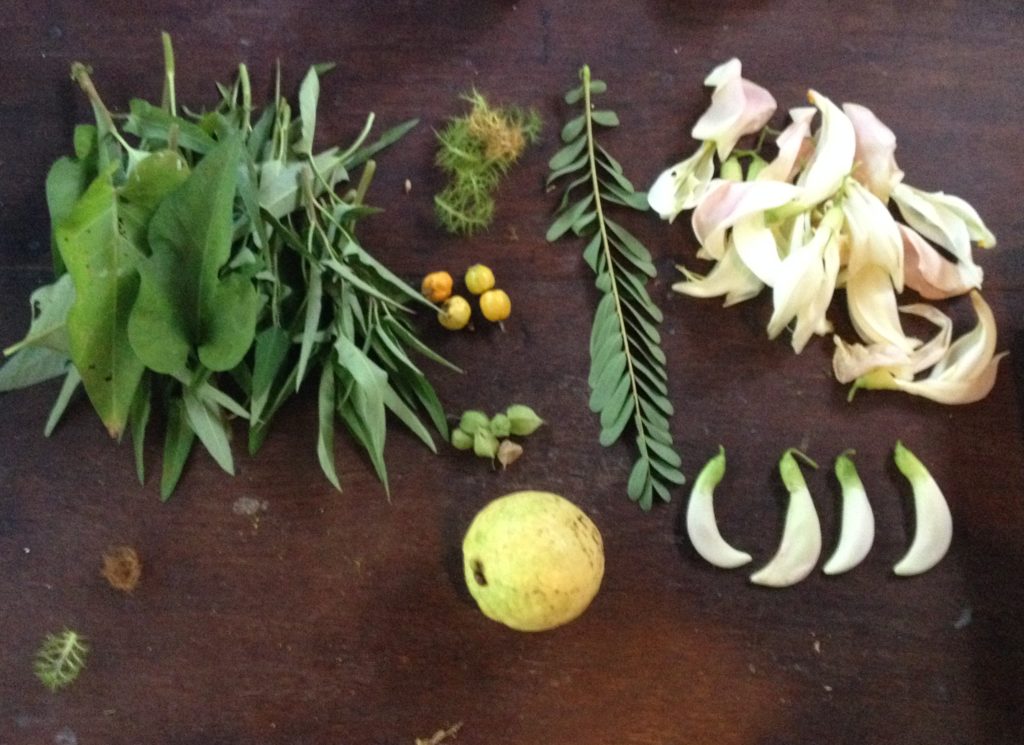
The father of modern medical science, Hippocrates said: “Let food be thy medicine, and let medicine be thy food”. The saying still holds water across borders, culture and time. The prospect of food as medicine is a core belief in traditional Ayurvedic and Chinese medicine. Today, in modern medicine, validated by vigorous research and data, food-therapy is prescribed as a preventive tool for many diseases by nutritionists and doctors.
Food not only fulfills our most basic needs of nourishing and upkeep of our body and minds; it is interwoven into our cultural identity and heritage. In this globalized 21st century world, food practices and preferences are imported, exported and shared. Accessibility and abundance of foodstuff have spiraled interests in culinary arts and gastronomy, connecting people and bringing world cultures together.
For a curious mind, hungrily exploring gastronomic adventures, food without variety becomes dull and boring. With plentiful choice, selecting, preparing and generally being mindful of our food habits becomes complex. Depending on where you are in the world, your diet may have a high environmental impact and may contribute to further pollution of natural resources. So the question arises, what is the nutritional value of the foods I love to eat? Will I get my money’s worth if I eat in a certain restaurant? Will the dish arouse the senses and satisfy my hunger? Are the food I consume sustainably produced? Does it fall under fair-trade where farmers and producers are honored and given a fair share?
The necessity for food is real. Nutritional content of what we eat determines the composition of our cell membranes, bone marrow, blood, hormones, tissue, organs, skin, and hair. Our bodies are working to replace billions of cells every day using the foods we consume as the source.
A balanced diet is key for health maintenance and disease avoidance. This translates to largely plant-based, fruits and vegetables diet consisting of nuts, legumes and low amounts of lean animal proteins. Eating healthy amounts along with physical activity keeps our minds and body healthy in the long run. There are no shortcuts; stocking up on superfoods and trying out controversial diets, might not be effective in the long run but most likely you will end up with a lighter purse and no added value to your efforts.
Food industry and marketing gimmicks signal to us that rare and exotic plant products, with high price tags, flown across the world are essentially more nutritious for us. As many of us are refining our diet, away from fast-food, processed instant-food and becoming more health-conscious, to capture our enthusiasm, food marketers flash trendy labels and make up meritless terms such as “superfood” to lure us in.
The term “Superfood” does not have a valid scientifically approved definition neither it is a distinct food group. Most who boast of the greatness of superfoods, agree that plant-based products that are fresh, vibrant, nutritionally dense, less processed, rich in antioxidants and phytonutrients are much more superior than bland and refined food. These power plants are said to have the potential to aid in weight loss, promoting brain, skin and hair health, boosting immunity and aid in gut health. What is far more important than chasing food fads is focusing on healthy eating patterns and possibly choosing food that is locally grown.
By buying food that is locally produced, we are supporting local farmers to help maintain green spaces and money invested in community funds. Fresh seasonal fruit and vegetables are more flavorful, and retain more nutrition than fruits and vegetables that has been picked prior to ripening, sits in various distribution centers before being shipped to us from every corner of the globe.
Here, We have compiled for you a list of superfoods that are wildly and organically grown in the Maldives. All the ingredients are easily available from our island gardens, farms and markets. Let’s rejoice and embrace the benefits of choosing locally.
Dhonalha (Sorghum)
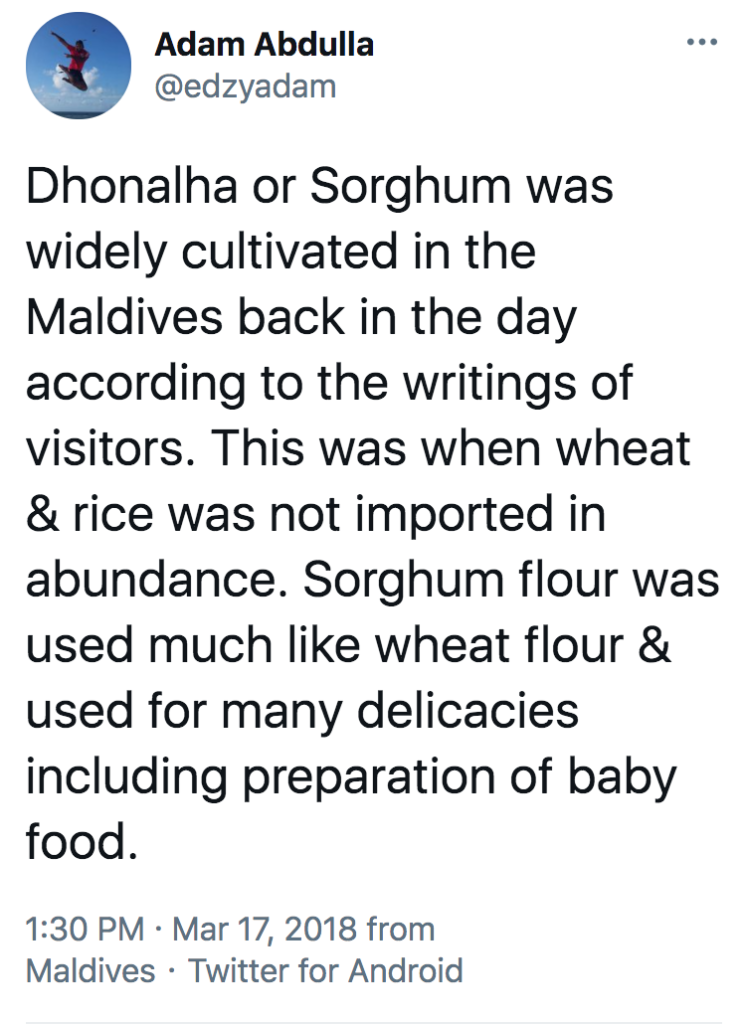
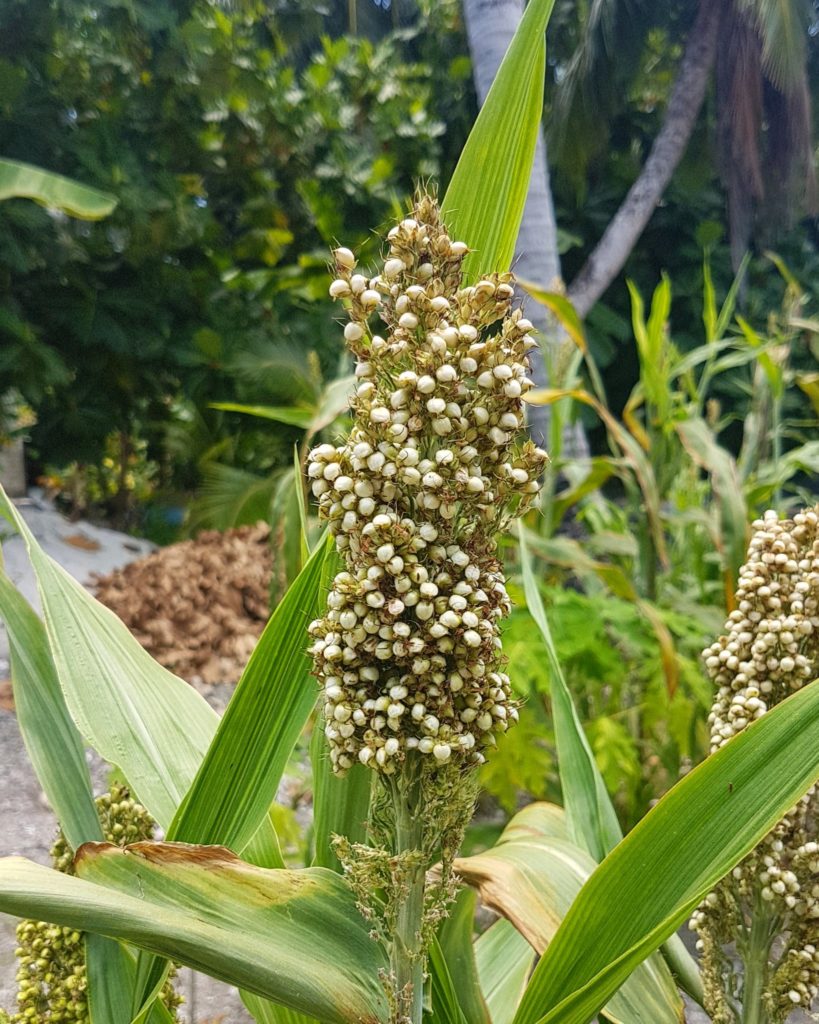
This plant from the grass family has been cultivated in the Maldives from ancient times but declined in the recent past with the commercial importation of grains and flour. This powerhouse grain is a staple, starchy food source in Africa, India, China, and parts of America and Australia. It is an efficient crop with high resistance to heat and drought, requiring less water compared to other whole grains.
By introducing local super cereals such as dhonalha in their menus; resorts, local restaurants and guesthouses are helping customers acquire healthy alternatives while creating opportunities for farmers. Reviving ancient crops can aid in food security and climate change adaptation.
This 100% gluten-free grains can replace quinoa. It is a cheaper whole-grain alternative for; rice dishes, added to salads and breakfast bowls (after popping them like popcorns to give a nutty flavor and a crusty crunch). You can ground sorghum meal to make gluten-free cakes, roshi and breads, giving your baked goods an earthy undertone and nutty character. Here is a traditional dhonalha boakibaa, a local recipe to satisfy your sweet tooth.
The tiny grains are rich in; carbs, a good source of plant-based protein, vitamin B, calcium, niacin, soluble fiber and antioxidant profiles. Improve digestive health, promote bone growth and boosting energy levels are some of the benefits related to sorghum.
Now is the time to reinvite this wonder grain into our diets and plates, connect with our traditional local cuisine and make it feasible for local farmers to grow it in our islands.
Thoothu (Mulberry)
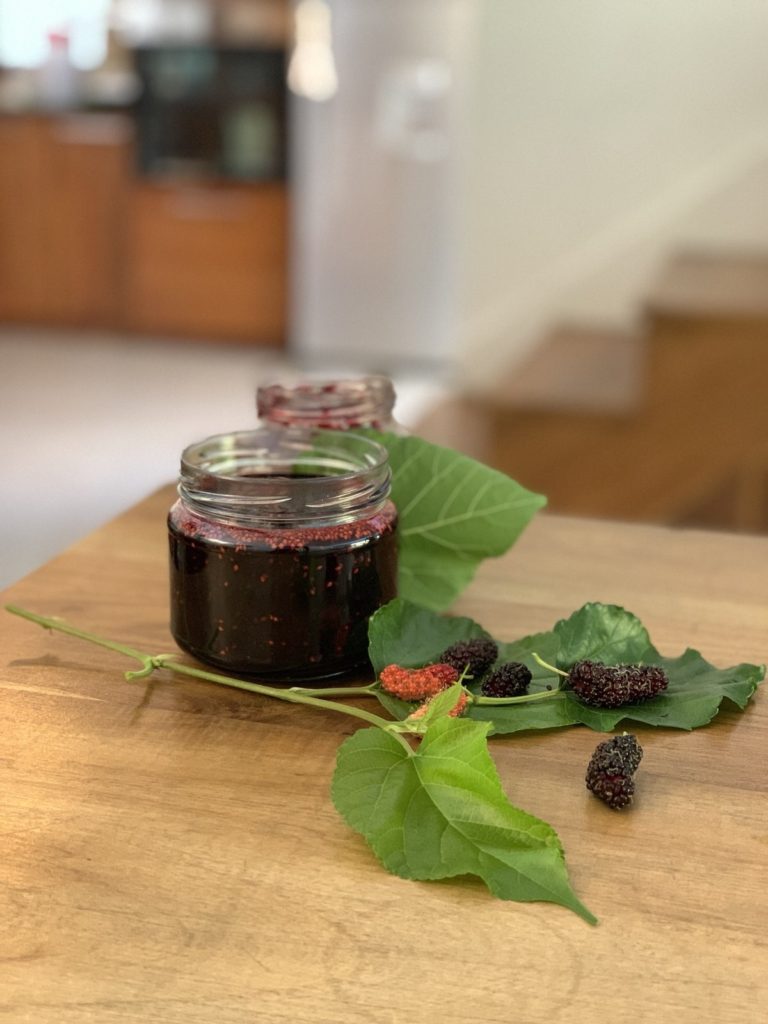
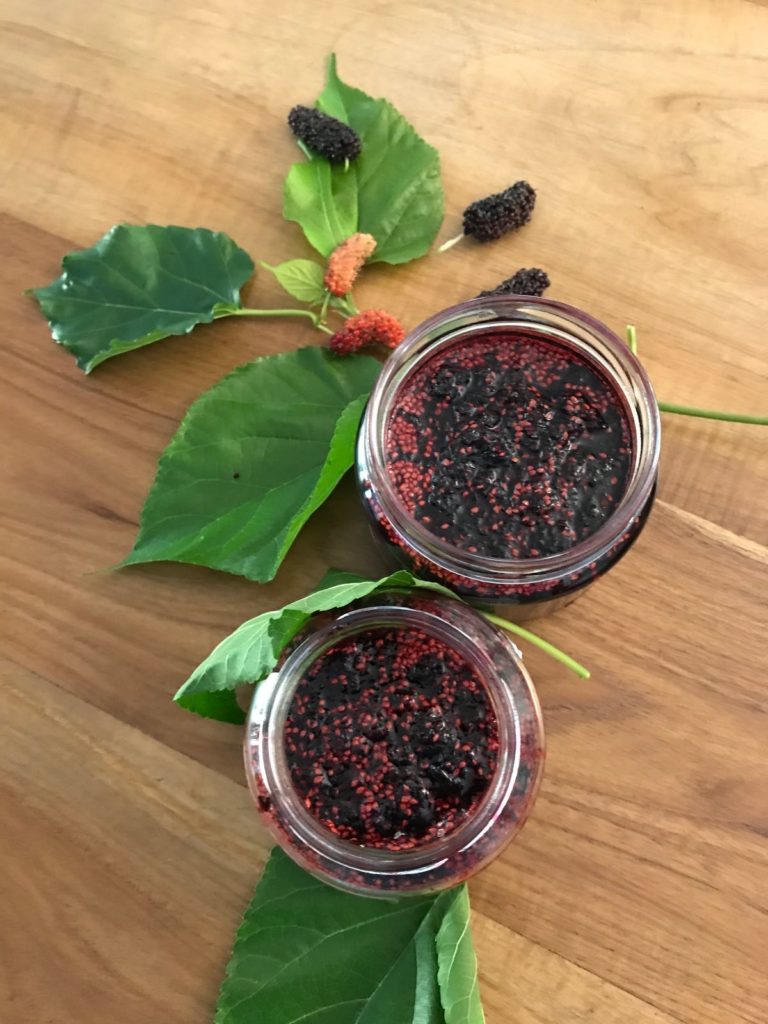
The most popular variety of this superfood is considered to be white mulberry (Morus alba), naturally occurring in parts of China and India. Morus rubra (red) and nigra (black) are the common varieties grown in Maldives.
The red and black berries contain similar nutrition profiles as the most sought after ‘it’ variety. Try the local equivalent, sweet and tarty when ripe, the dark deep pigments is sure to stain your mouth burgundy. It is a delicious substitute for blackberries, raspberries, and blueberries; to be dried and used, mixed in with your smoothies, a tasteful garnish to fruit juices and punches.
The plant can easily be grown in pots or ground, right fit for our weather condition. Food enthusiasts and health educators assert on the berry’s potential to; lower blood cholesterol and sugar levels in addition to reducing risk of cancer in humans. This maybe due to the fruit having high antioxidants, vitamin C, B complex and iron contents.
These juicy berries can be used to make jams, pies, tarts, wines, cordials, and herbal teas. Another fun way to use them is by making environment friendly natural fabric dyes; turn your old tees, new and colorful with fruits and veggie dyes.
Jeymu (kerson fruit)
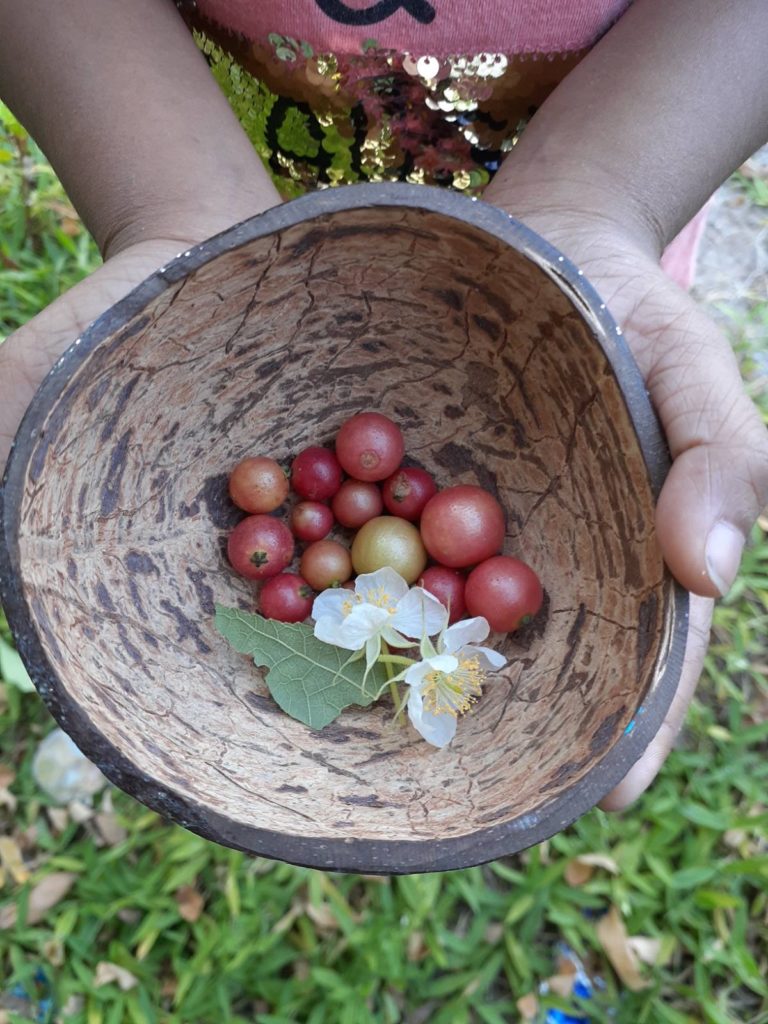


Jamaican cherry tree is found throughout the Maldives. The flowers look like beautiful Japanese cherry blossoms. Although odorless, these edible flowers are used to make a delicate herbal tea infusion. In many traditions, it is used to remedy headaches and symptoms of common cold.
Shaded under the branches that weave a cozy shelter of leaves, is the ideal spot to past time and relax on a lazy sunny afternoon. Young leaves are brewed fresh or dried into tea, cold drinks or taken as a health supplement.
Even though we here in the Maldives are unfamiliar with the leafy concoctions created from this tree, we are no strangers to the juicy delicious fruits the tree gives. These succulent berries, filled with tiny sand-like seeds are sweet and some say tastes of strawberries. During the fruiting season, children, adults and fruit bats share an insatiable appetite for Jeymu. They are freshly picked and eaten raw or blended to juice.
A quick tour of the internet reveals numerous health claims to this berry; dubbed the “miracle fruit” it can lower and stabilize blood sugar levels in diabetes, treat heartburns, stomach ulcers and gastro esophageal reflux disease (GERD). Like any other vibrant sour berry, it is rich in vitamin C, fiber and antioxidants.
We can demand to cultivate this tree and reap myriad of benefits by creating new flavors, mixing precious ingredient as this into jams, cordials, baked goods and other sugary delights.
Gandhakoalhi oh (Basil seeds)
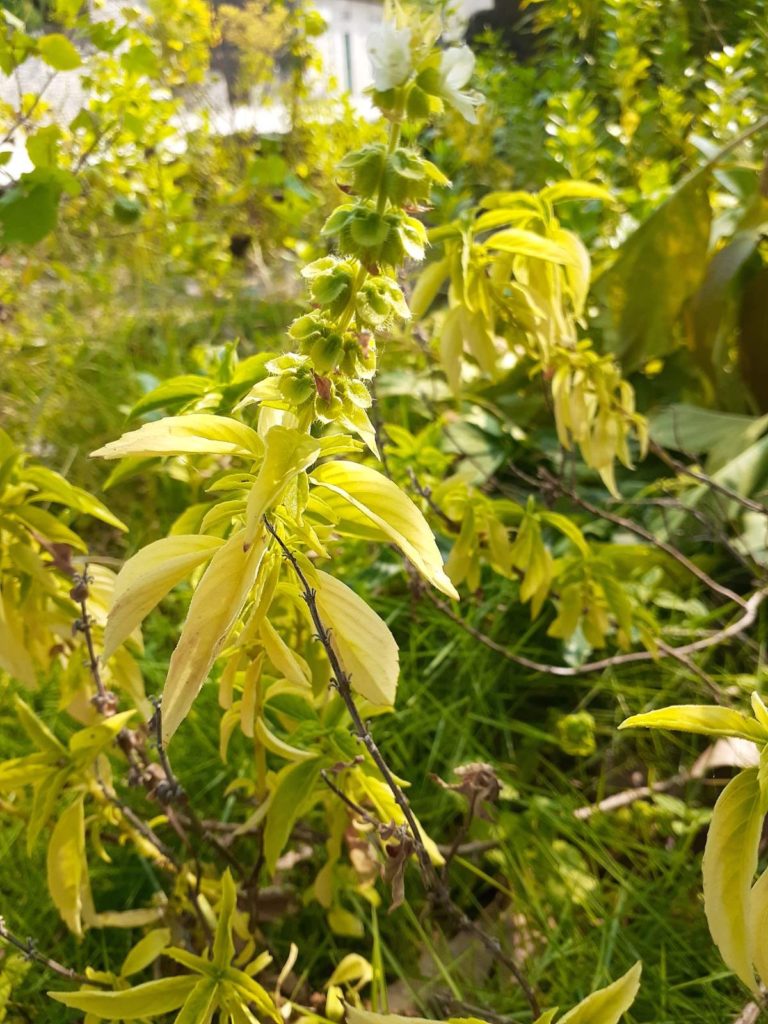

With a burst of popularity, basil seeds have become the new chia seeds. Sweet basil seeds are jet black, teardrop shape and tiny as chia seeds. Like chia; when soaked in water they form a jelly coat around the seed, have similar thickening properties and chewy texture. Fortunately, the latest super seeds are easy to find, grow and use here in the Maldives.
With twice the iron, fiber and potassium, calcium ratios than chia seed, they are hailed as a weight-loss wonder. They reportedly have high amounts of antioxidants, vitamin K and iron–the reason why a lot of beauty enthusiasts confirms its skin and hair care prowess.
If you have a basil plant, it is quick and easy to collect the seeds. Just let the flowers develop to seed, once they start to dry, cut the flowers and put them in a plastic bag, close and shake around to remove the seeds. You can sieve or handpick the flower stalks and debris. There you have it, the ultimate super seed; homegrown and processed by you.
Go ahead and reap the rewards by adding them into fruit juices, milk teas, blend into smoothies, your favorite breakfast bowl, sprinkle on top of salads or your green-combos.
Muranga (Moringa)

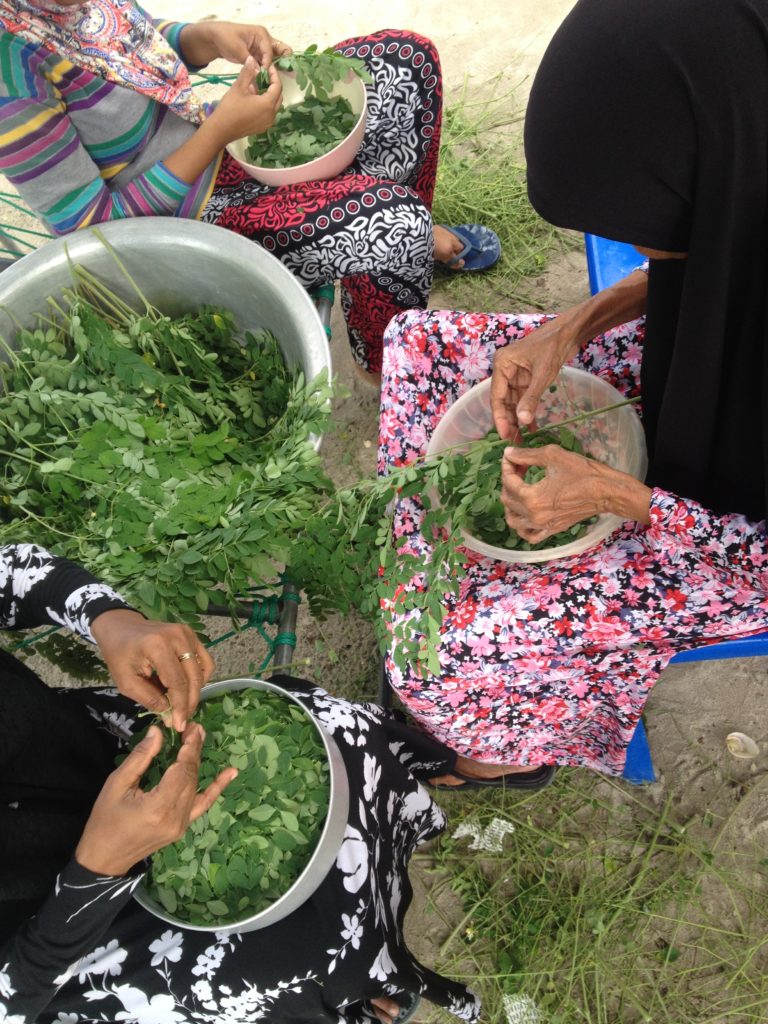
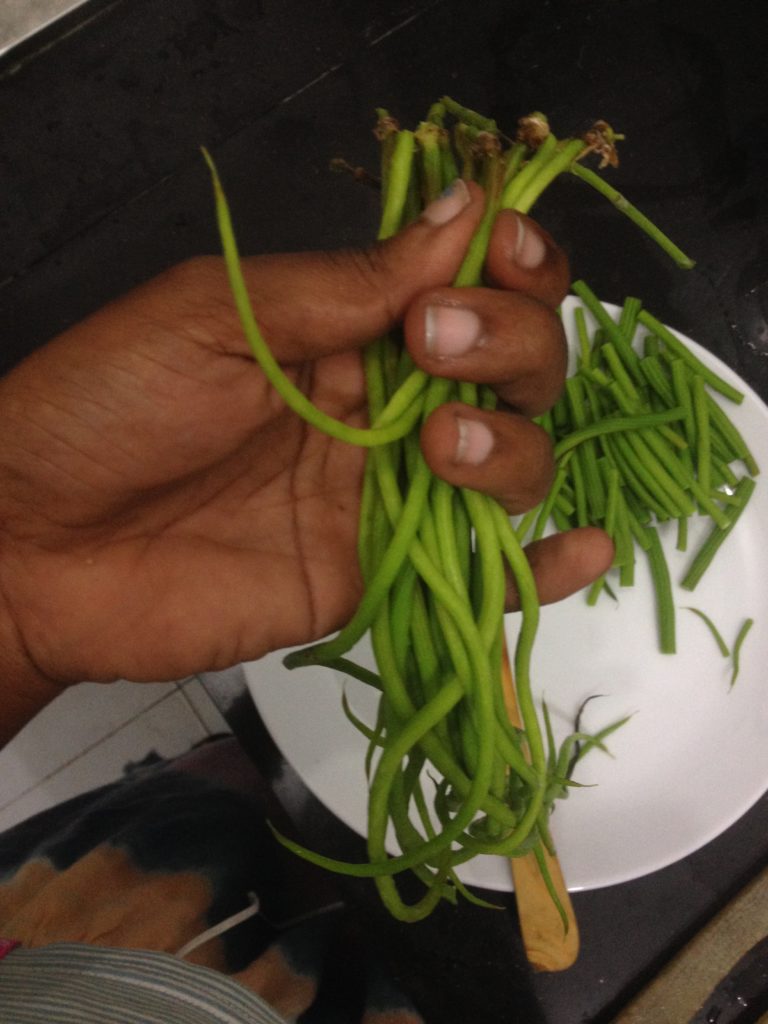
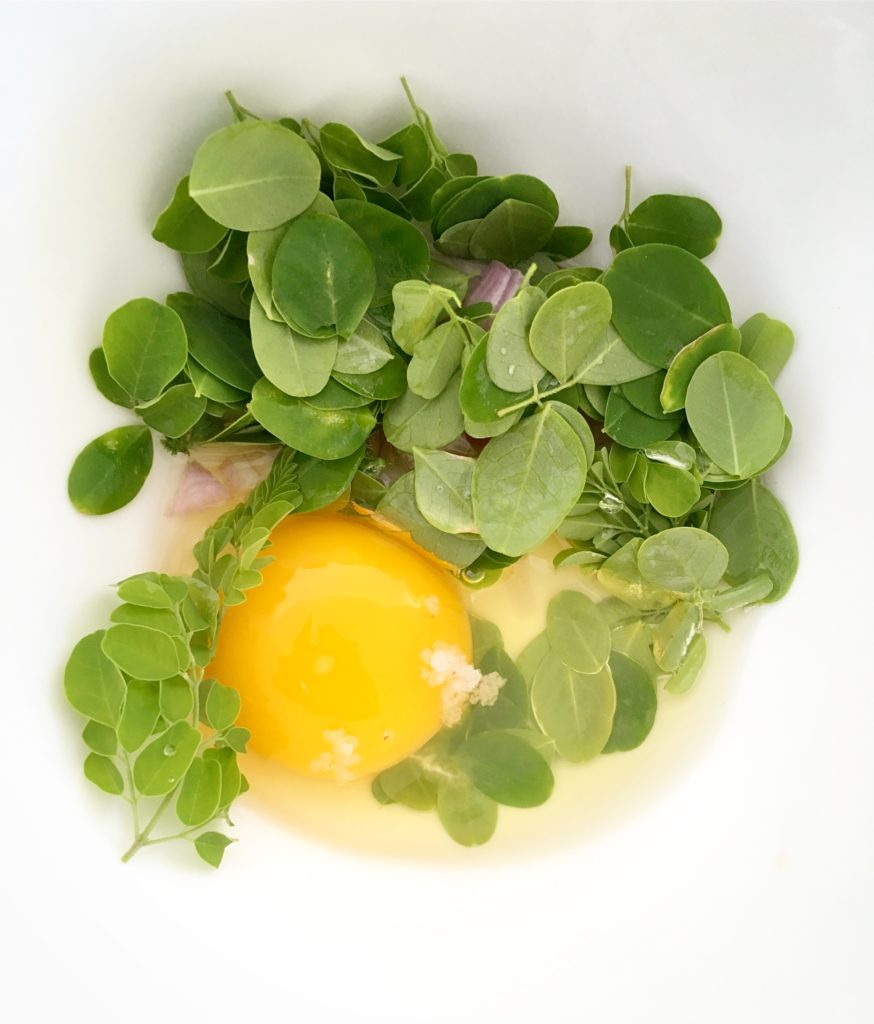

This just may be where the global and local food trend meets. Muranga tholhi and faiy has been the preferred super green in Maldivian cuisine, it is widely used in north as well as southern atolls. Eaten raw, curried or fried, Moringa preparations are served with any local meal and in every Maldivian feast. Around 2017, Moringa oleifera started making waves globally as an even healthier and environmentally better option than Kale and Matcha. The positive reputation is now backed by research and medical science. Nutritional assessments of leaves, stems, pods and roots reveal high nutrition density and medicinal qualities historically valued in Ayurveda and traditional medicine. For anyone who’s taking the nature’s way to supplement their diets, dehydrated Moringa powder might be the answer.
Moringa is packed with vitamin A, C, Calcium, Potassium and many other antioxidants, phytochemicals and high amounts of fiber. Another reason for the soaring support for the protein-rich plant is that it grows well in drought-prone areas where water shortages are a common occurrence. It is a vital source of nutrition for those countries where the diet is nutrition deficient.
Growing this plant can help feed the world.
Budding technology and new processing methods, guided by product research and development, new innovative Moringa products can help stimulate our health and wealth of our economy.
Kaashi, Kurumba (Coconut)
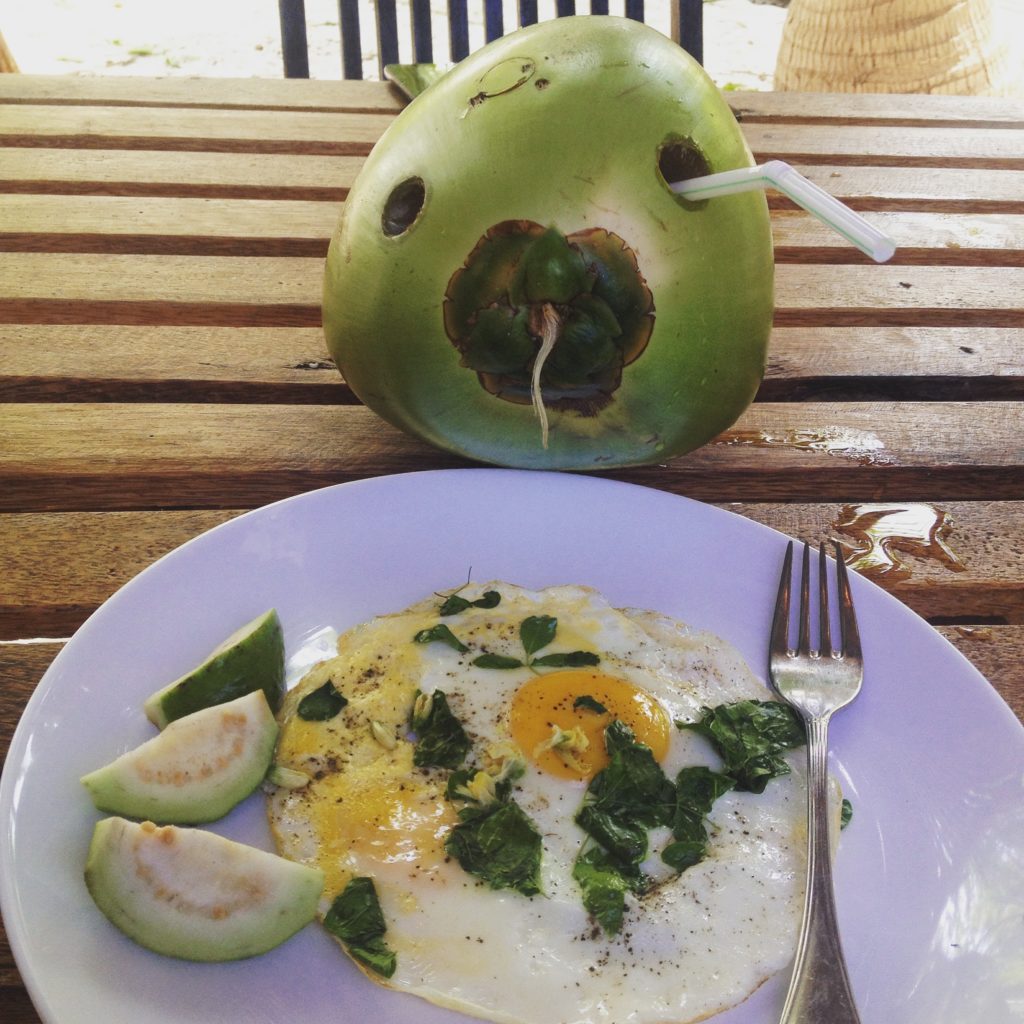
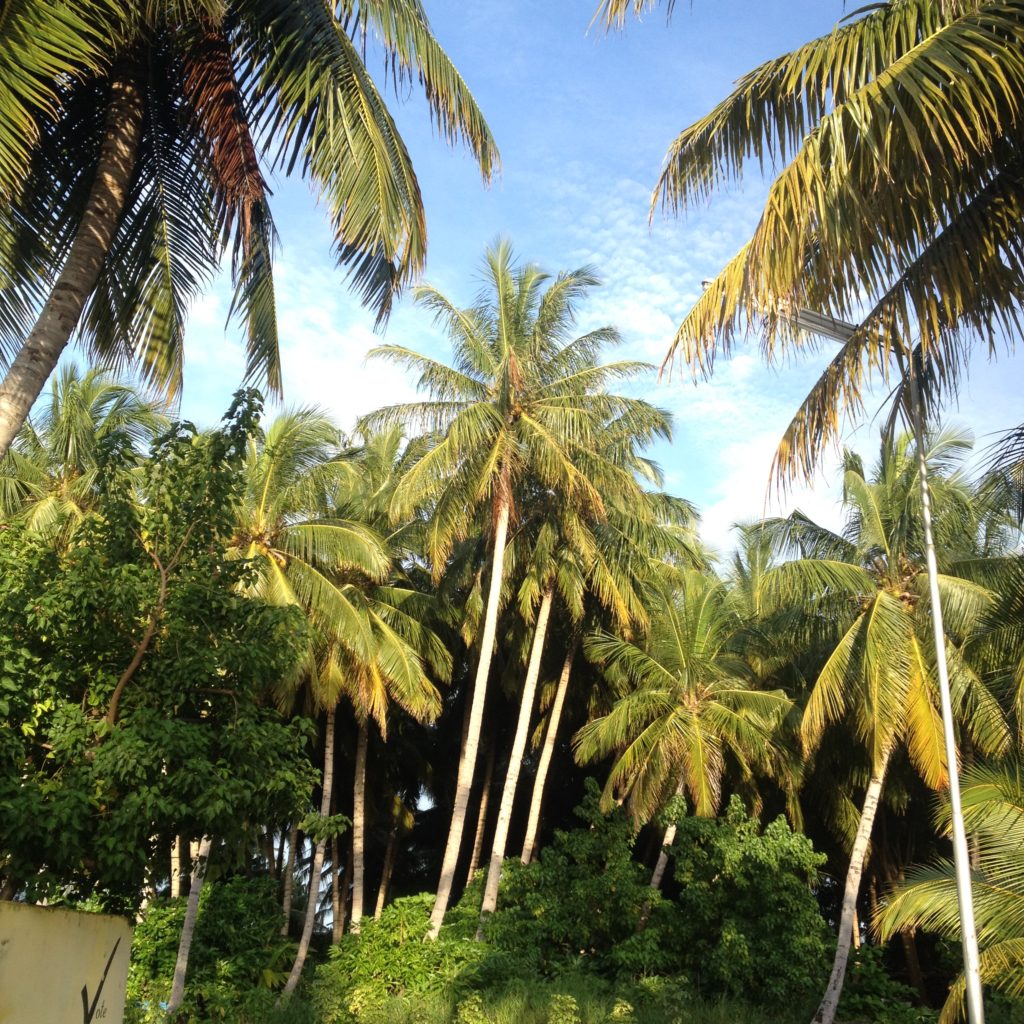
The coconut palm is one of the most resourceful plants growing in our islands. From young coconuts, toddy to wood, all are diversely used in our culture. Today, worldwide, people are discovering old and new, unique ways to use the humble coconut as a natural health food, skin and hair care ingredient.
Health, wellness and beauty industry write rave reviews on coconut oil; to be a body fat burner, good for heart health. Applied topically on the skin it hydrates, lock in moisture, used to heal wounds due to its medicinal, anti-bacterial, fungal and viral properties.
Kurumba/Young coconut water is a much hyped-up sports drink by fitness-first and active people as a natural alternative to Gatorades and other artificial glucose drinks loaded with sugar. The main reason why coconut water gained recognition is for its electrolyte content, responsible for hydration and upkeep of muscles and nerves, very refreshing after a sweaty workout.
The demand and number of people going nuts over coconuts increases, but a coconut shortage is looming on the horizon. The world coconut population is now ageing. In this challenging time of climate change, coconut growing regions in support with world agricultural organizations are working to save the palm. The government of Maldives launched a coconut replanting program across the country, led by the Agricultural ministry and island councils; aiming to increase the number of productive, disease-resistant, suitable varieties in the islands.
There is a wide selection of dairy and gluten-free coconut products sold in the market ranging from; oil, sugar, honey or treacle, milk, amino, cream, shredded, desiccated, flour, chips, vinegar and the latest coconut-fueled product is powdered coconut-protein made of coconut meat which has levels above quinoa when it comes to its protein content.
This life-giving-tree-of-life has been a part of our cultural identity for centuries. Unlike many fleeting global health food trends of our time, it feels like the love for coconut is here to stay, full-time.
